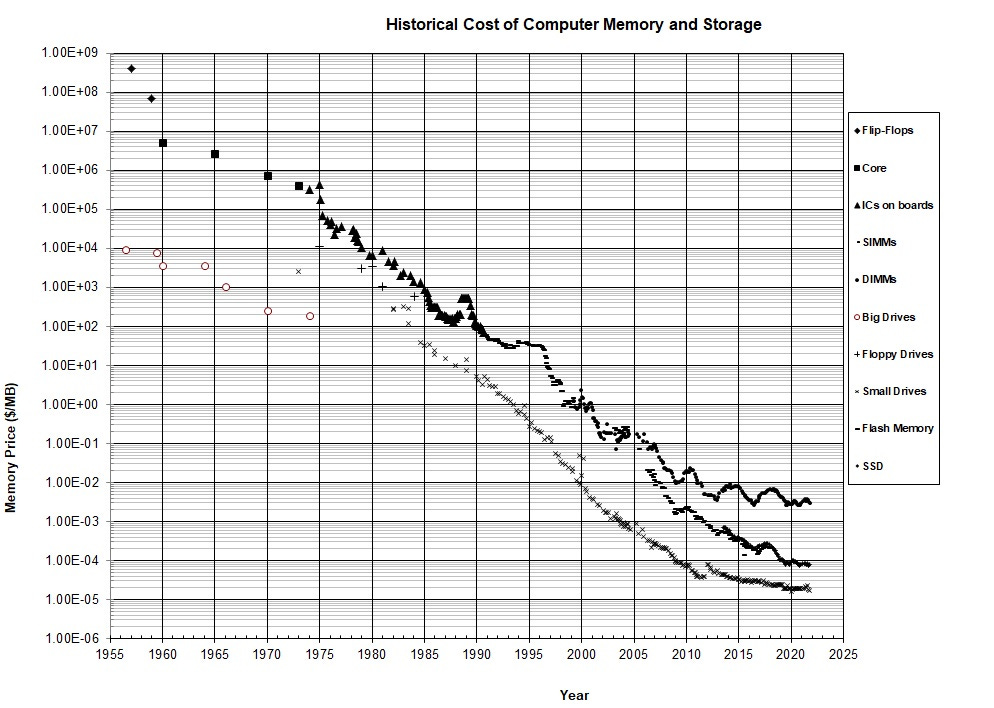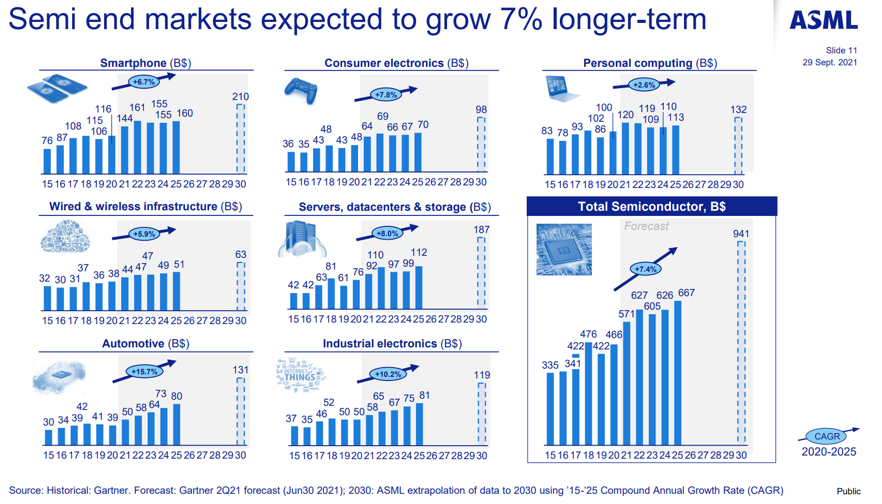In the Middle of Transition: 2022 Semiconductor Outlook
What would the shift from cyclical to secular look like?
A strongly held belief I have is that semiconductors are in the middle of a new golden age. I think that most of my readers would agree. But something that’s always concerned investors is the industry’s cyclicality. Of course, it worries me, too, but as the “chip shortage” has gone on longer and longer I’ve pretty much concluded that no one knows when it will end, and in many ways, this would be exactly what the shift from a cyclical industry to a secular market would look like. Let me explain.
The semiconductor market for years has been characterized by booms and busts. Below is a handy long-term graph of revenue growth. I added the black line as emphasis for 0% YoY growth, meaning if the red line is above the axis, revenue expands, but if it’s below, it contracts. Historically, the boom-bust cycles are primarily driven by supply.

The core reason for this is that capacity additions are extremely lumpy and adding new capacity via a fab came with huge fixed costs, and then very low variable costs, especially in sub-sectors like memory. The incentives were obvious. If you had a new fab, you could use your marginal cost advantage to offer a cheaper product and, in the process, blow up the total profit pool. In many ways, this was the story of the ~80s-90s memory market. The YoY numbers from that time make the ~2000-2002 wobble look tame. The wild fluctuations on this log chart of memory prices pretty much tell the entire story, with dozens of companies adding capacity and massive benefits from each new technology generation in terms of capacity.
But of course, things changed. Moore’s law slowed down and the rising cost of making semiconductors from both the fabrication and design perspective has forced consolidation and more rational industry competition. Why blow up the profit pool of your entire industry when the magnitude of costs is reaching tens of billions of dollars? Why not add capacity in a more disciplined manner given that you know what your competitors are doing? This is exactly what’s happening in memory, the most hyper-cyclical part of the industry. Most of the more mature semiconductor segments have already started to focus on their own product fiefdoms. With little competition head to head and only at the margins. Consolidation also helped quite a bit.
Another large driver as software eating the world and semiconductors being used in more and larger parts of the economy. Our cars and our homes took more semiconductors, and of course, our phones became much more integral parts of our lives. We went from essentially one market in the 1990s (PCs) to multiple end markets today. My favorite chart of the different vibrant end-markets came from the ASML investor day in 2021:
The important thing is that each of these cycles are happening independently. For example, phones are starting to slow down in volume as the average life of a phone increases, while automotive companies are just starting to ramp EV and ADAS content in their cars.
This is a simple expression of the law of large numbers. If semiconductors have a positive growth relationship it would mean that the bigger the number of different markets that are not correlated, the closer the aggregate results will approach the underlying trend. Each new diversifier will lower the volatility of just a single market’s results. I think that’s happening today.
So back to the path of cyclical to secular growth and what it would look like. Especially for a cyclical industry, each time there’s a year of sustained strong results there’s an expectation of a reversal to the mean. As bullish as I am, I don’t have the guts to say, “growth only, no down years.” That kind of statement is insane to make if you’re in the business of having reasonable accurate projections given the historical base rate.
But right now, we have clear indications of new demand streams from AI, new industries, and the broader slowing of Moore’s law. We also have more disciplined and consolidated supply, and despite the crazy capacity additions that have already taken place, the industry continues to grow. Semiconductors seem to have swapped from a supply-driven industry to a demand-driven industry since the pandemic. That, to me, is the big key of what the cyclical-to-secular market would look like. Additionally, semiconductors actually grew through a recession, which is pretty telling for the secular argument.
If there were ever a scenario of an historically cyclical and supply-driven market shifting into a secularly growing, demand-driven market, we’re living in it. Students of history know that each year there should be a supply-driven correction at some point, but each year the balance of supply and demand looks to be in demand’s favor. So, while we think that the continued and consistent supply additions will eventually turn the market, demand continues to outweigh supply additions.
If this sounds familiar, it’s because it’s pretty much the regime we’ve been living under since 2020. The chip shortage was originally expected to abate or turn around by the end of 2021 and that looks like it won’t happen. Now it’s expected to end in 2023, but it’s not like there hasn’t been a huge capacity addition since last year. The supply-demand crossover always seems to be just one year away. What’s happening? Why haven’t the recent capacity additions relieved the supply-chain crisis? An exchange that I thought was pretty enlightening was this conversation on the Q3 2021 ASML earnings call, answering an analyst’s question:
Yes, Sandeep. I mean you've been around a long time and you asked the million-dollar question. So — and the real answer is we don't know. We have some indications and some ideas. And yes, you are absolutely right, the wafer out capacity today is a big — is a lot larger than it was in Q4 2020. That's true. And still, we see these shortages. Now I spoke to a very large customer and basically asked the same question.
And I actually said, Peter, we don't know either. Because somehow we haven't been able to connect all the dots that actually are the underlying drivers for this demand.
This sounds like an anecdote in favor of the shift towards a demand-driven market. Each year, massive supply is added, yet demand continues to simply outweigh it. That would be what the “secular growth” case would look like for me, and in some ways we’re in the perfect expression of that transition. We’re in the middle of it.
Now, to be clear, I’m a student of history and not irrational enough to call the end of the booms and bust in the semiconductor market. There’s just no way I can make that call in good conscience! But I think it could happen at, say, a ~30% probability, and in many ways, we’re doing the things that would be needed for this to happen. I just want to highlight that if the shift were to occur, it would look almost exactly like what’s happening today.
We’ll just have to wait and see. The visibility of the industry is one year at best, but the one-year forward expectations look pretty good to me. I think particularly driven by Datacenter, IoT, and Automotive, there’s a chance the industry could put up a historic double-digit growth year. That kind of sustained expansion is something we’ve never seen in the semiconductor markets of old. But if this really is the shift from cyclical to secular, this is what we should expect.
Anyways. I want to post a webinar of me and Dylan talking about the semiconductor markets by end market for 2022. This is a bit of a more typical 2022 outlook if you ask me, but I wanted to add this one caveat that if semiconductors are really going to be a secularly growing industry, we’re clearly in the middle of what that transition would look like.
Performance in 2021
Without further ado let’s go into name-specific returns year-to-date and an overview of the space.
The best-performing stock this year was Synaptics. The worst was OLED. I’m not surprised at OLED, but I am surprised to see the absolute strength of everything “IoT”-related. Synaptics is primarily an IoT-related company, SITM to some extent is an IoT-related name, and so is Nordic Semi. Amba is an automotive name but also partially IoT. Getting the theme here?
On the loser side of the equation, some names I’m not that surprised to see are here: WOLF and Intel, to name a few, but additionally FSLR, SEDG, ENPH, and POWI. The first three names are solar-related, and 2020 was the wildest solar year ever, so a cooling-off period makes sense to me. I’m also kind of interested in these companies from that aspect. POWI was an expensive momentum-driven name, so no real surprises there. But beyond price return, how much of it was fundamental- versus multiple-driven?
Valuations of the Space
Most of the winners in terms of price were driven by multiple expansion, but a few names did benefit from mostly earnings-per-share growth — especially the worst performers. Companies that had positive EPS growth and negative price return in my opinion are likely the place to hunt for bargains next year. Companies that grew earnings faster than price this year include SITM, ON, MXL, AMKR, AMD, DIOD, LRCX, BESI, NXPI, STM:FP, MTSI, ALGM, MPWR, IFX:GR, MU, QCOM, ADI, MKSI, TXN, POWI, CRUS, WOLF, ENPH, SWKS, QRVO, FSLR, SEDG, and OLED.
From this list alone, you’d assume that Automotive, RFFE, and solar is the place to play. I think it’s not quite as simple as that. I would avoid RFFE and am starting to be interested in solar. That being said, I continue to believe that automotive has one of the best mixes of price and growth in the entire space, and the likes of ON, NXPI, STM, ALGM, IFX, ADI, and TXN are worth a second look.
I think that semiconductor stocks are in an okay place right now. I continue to love areas of well-priced secular growth relative to the market (Metrology!), but I continue to worry about lapping issues by the end of this year, especially in Semicap. I think that right now we’re hitting the hardest year-over-year comparisons for revenue growth and it’s hard to see acceleration from here. This is my “concern” broadly for semiconductor-related stocks and I believe that from a top-down perspective most companies should decelerate this year.
I would summarize by saying that 2021 was one of the best years fundamentally for semiconductor companies. Almost every company grew – and most grew much faster than the industry growth of 24%.
On top of that, certain companies managed to do much better on an EBIT growth basis. The average company’s margin expanded, which should be expected given high fixed costs. Certain companies’ margins expanded meaningfully, like ON, MXL, SITM, and AMBA.
By the way, I plan to start up the “monthly stock price review,” similar to the one I used to do before the hike. I really enjoyed writing those, mostly for myself, as it’s a way to systematically look at the entire universe. It helps be vigilant from a top-down perspective and make sure you’re not “missing anything.” Frankly, I missed some companies this year, and part of that was the transition of coming back after being gone for so long. No longer!
Happy New Years, y’all! Here’s to a better year for us all. It’s been a good year for semiconductors, but I for one wish for a great year for all of us. 2020 of course was a rough year, and 2021, while marginally “better,” wasn’t the greatest. 2022 I hope is an opportunity for a great year for everyone. Stay healthy and safe!







